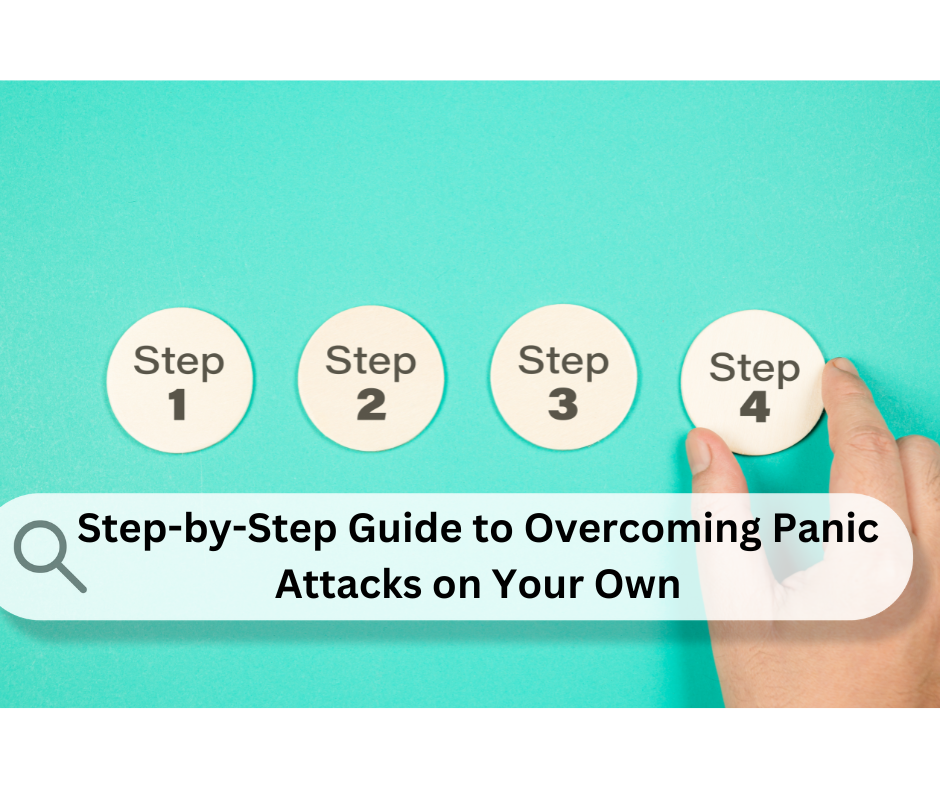A Practical Plan for Stopping Panic Attacks on Your Own
I’m trying to put as much self help material as possible on my site, with a view to you being able to help yourself at home, without therapy, in this case with panic attacks, and if necessary progress to more formal self-help, before working with me for therapy sessions. This article is the bottom rung of the ladder where I shall take you through a structured, step-by-step approach to overcoming panic attacks using proven psychological techniques. I’ll walk you through immediate coping strategies, long-term recovery methods, and how to create a personalised self-help plan that works for you.

All my self help material shall be in this self help category, and more for CBT related material, you can find that in the CBT category.
Before we start, it’s important to understand what’s happening when you experience a panic attack. Learn more about panic, in my Guide To Panic Disorder.
- Panic attacks are not random. They follow a pattern—often triggered by certain thoughts, body sensations, or situations.
- They are a false alarm. Your brain mistakenly interprets something harmless as a threat, triggering the fight-or-flight response.
- What you do during a panic attack matters. Your reaction can either reinforce the cycle or help break it.
Struggling to Manage Panic ?
I had panic attacks myself which is why my course was to help people learn to deal with panic attacks.Online course is available to start right away and costs €89.
Keeping a panic journal for a few weeks can help you spot patterns in your attacks. Write down:
- Where you were
- What you were doing
- The first symptoms you noticed
- The thoughts that went through your mind
Once you start recognising these patterns, you can intervene more effectively.
Step 1: Calming Your Body’s Panic Response
1.1 Activate the “Rest and Digest” System
When panic hits, your nervous system is in overdrive. The quickest way to regain control is by triggering the parasympathetic nervous system—the part of your body that naturally calms you down.
Try This: The Physiological Sigh
- Take a sharp inhale through your nose, filling your lungs.
- Immediately take a second, shorter inhale (as if “topping up” the breath).
- Slowly exhale through your mouth until your lungs are empty.
- Repeat 3-4 times.
Why this works: This technique mimics the body’s natural sighing mechanism, sending signals to your brain that it’s safe to relax. Learn more about using guided relaxation to help with panic attacks.
1.2 Release Excess Adrenaline
Your body floods with adrenaline during a panic attack. You can burn off some of that energy by engaging your large muscle groups.
Try This: Grounding Movements
- Wall Push: Stand up and press your palms against a wall, pushing as hard as you can for 10 seconds, then release.
- Leg Tension Release: Sit down and press your feet into the floor for 10 seconds, then relax.
Why this works: Physical exertion tricks your nervous system into shifting out of panic mode.
1.3 Redirect Your Attention
Panic attacks thrive on internal focus—you’re hyper-aware of your heartbeat, breathing, and dizziness. The goal is to shift your attention outward.
Try This: The External Object Method
- Grab an object (a key, pen, or anything nearby).
- Describe it in extreme detail—colour, texture, weight, shape.
- Keep your focus on the object for at least 60 seconds.
Why this works: This breaks the cycle of overanalyzing your symptoms, reducing fear-driven escalation.
Step 2: Rewiring Your Response to Panic
Stopping panic attacks in the moment is helpful, but real progress comes from changing how you respond to the fear of panic itself.
2.1 Change How You Interpret Symptoms
Panic is often driven by catastrophic thoughts. If your heart races, your brain may automatically think, “I’m having a heart attack.”
Try This: Symptom Reframing Exercise
Write down your usual panic thoughts and replace them with rational responses. This is reframing exercise come from Cognitive Behavioral Therapy and you can learn more about the model of CBT here, and how CBT helps with panic here.
| Panic Thought | Alternative Thought |
|---|---|
| “I’m going to faint.” | “I’ve felt this way before and I never fainted.” |
| “I’m losing control.” | “This is uncomfortable, but I am still in control.” |
| “I need to escape.” | “I can stay where I am and let this pass.” |
Why this works: Over time, your brain learns to stop associating bodily sensations with danger.
2.2 Gradual Exposure to Triggers
Avoiding situations that trigger panic keeps the fear alive. Instead, gradually expose yourself to them in small steps.
Try This: The Comfort Zone Challenge
- Make a list of situations you avoid.
- Rank them from least to most anxiety-provoking.
- Start with the easiest one—stay in the situation until your panic fades.
- Move up the list as your confidence grows.
Why this works: Facing fears in manageable doses retrains your brain to stop reacting with panic. Learn how to use exposure therapy to help with panic.
Step 3: Creating a Panic-Proof Lifestyle
3.1 Balance Your Nervous System
Your body’s ability to handle stress affects how prone you are to panic attacks.
Daily Practices for Nervous System Regulation
- Deep Breathing: Spend 5 minutes a day practicing slow exhalation breathing.
- Cold Exposure: Splash cold water on your face or take a brief cold shower—this stimulates the vagus nerve, promoting calm.
- Gut Health: Research suggests gut bacteria play a role in anxiety. Consider incorporating probiotic foods like yogurt or kimchi.
Why this works: A well-regulated nervous system makes panic attacks less likely to occur.
3.2 Set Up a Panic Prevention Routine
- Limit caffeine and alcohol. These can make your nervous system more reactive.
- Establish a regular sleep schedule. Lack of sleep lowers your ability to cope with stress.
- Exercise daily. Even a 10-minute walk can help stabilise your mood.
Why this works: Small daily habits create long-term resilience against panic.
Final Thoughts: Taking Charge of Your Recovery
You can overcome panic attacks on your own—but it takes patience and practice. For more in depth help you can read my article on how to stop panic attacks. This guide gives you a clear framework to follow, but real change happens when you commit to applying these techniques daily.
